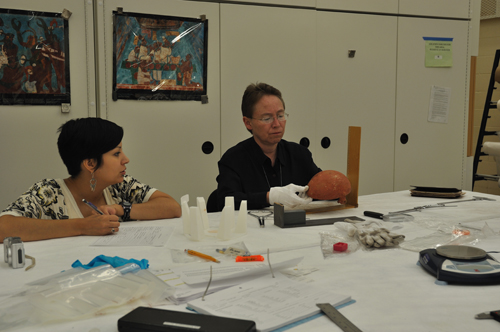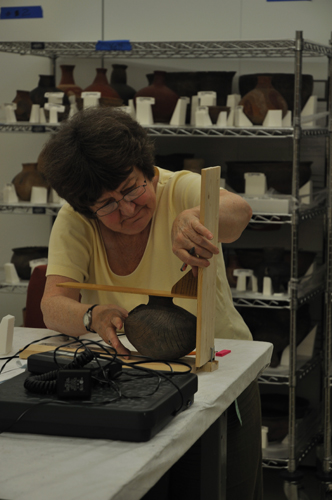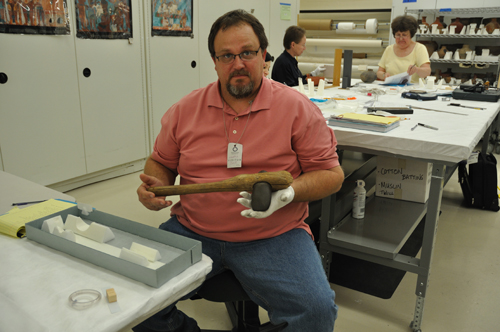Documentation of Carden Bottoms Artifacts at the
National Museum of the American Indian, Suitland, Maryland Arkansas Archeological Survey Our visit to document Carden Bottoms collections at the National Museum of the American Indian curation facility in Suitland, Maryland took place on May 17 – 22, 2010. Dr. Andrea Hunter and Ms. June Carpenter of the Osage Nation, and Dr. Ann Early, Mr. Jared Pebworth, and Ms. Leslie Walker of the Arkansas Archeological Survey participated in this activity. Before the visit, we requested information about the NMAI collections from several counties in Arkansas that encompass the research area along the Arkansas River. Most important was Yell County where the actual Carden Bottoms locale is situated. Dr. Patricia Neitfeld, Supervisory Collections Manager, provided us with catalog information about objects in their custody from the counties in our study area. This information included file photographs, provenience and catalog details, and provenance information. Leslie Walker created printed binders of all the pottery vessels and selected categories of non-pottery objects. In order to spend time most efficiently, we prioritized the vessels by county, and established priorities for the non-pottery objects. Most important in the second group were diagnostic lithic artifacts and items of European manufacture. In descending order of secondary priority were shell artifacts, pipes, and objects of non-domestic function. We created two documentation forms, one for pottery vessels (Ceramic Documentation Form) and another for all other objects (Artifact Documentation Form). These forms are designed to consolidate all relevant information efficiently and consistently, including current and previously used catalog data, artifact type and variety, photographic information, key dimensions, and a set of additional observations. The dimension information includes such standard categories as maximum length, width, thickness, and so forth. For pottery vessels, a series of dimensions for specific body parts such as bottle neck, body, base, rim, and appendages are recorded. Observations include raw material categories, color, surface treatment, category of decorative treatment, temper, general vessel class, presence or absence of use wear and modification, and so forth. Space is provided on the forms for photographic catalog information, artifact sketches, and narrative observations. For the other artifacts, the documentation forms have checklist sections to speed and standardize the recording process. Both forms are designed to be comprehensive and at the same time as generic as possible so that they can be used for recording the widest possible array of objects. We carried photographic equipment, measuring devices, low-power magnifying lenses, and the pre-organized documents with us to the NMAI facility. Thomas Evans, Museum Specialist at NMAI, removed the objects we were interested in from the storage cabinets before we arrived and consolidated them on a set of shelves in the open work area. We organized a staged protocol to carry out the documentation. Leslie Walker photographed all objects and recorded negative information on a set of photo files. When he had finished his tasks, Jared Pebworth assisted in the photo recording process. Andrea Hunter, June Carpenter, and Ann Early documented the pottery vessels. A vessel was removed from the shelves, the catalog sheet was removed from the binder, and the documentation sheet was filled out. Observations and measurements were taken with metric calipers, bone boards, hand lenses, and Munsell Color catalog books. When all the measurements and observations were completed on a vessel, it was moved to a separate table for photography and the two record sheets were placed in a ‘completed’ folder. After the photographs were taken, the vessel was placed on a ‘completed’ shelving unit for return to the storage cabinets.
Jared Pebworth documented the lithic, shell and other objects that included ceramic pipes and items of European manufacture. He followed the same procedure as that used for the pottery vessels. Several of the catalog numbers were assigned to large numbers of lithic artifacts in the same storage container. In such instances, the late prehistoric diagnostic items were selected for detailed documentation. Other Archaic or Woodland Period objects mixed in were not documented at this time. Individual measurements were made with calipers, and these smaller objects were also weighed on a digital scale. Pebworth followed the same process of handling the objects and paperwork through the photographic process.
By the end of the week, the team documented approximately 1700 artifacts, including 275 whole vessels, 600 lithic tools, and 834 other artifacts (clay pipes, stone, clay and shell ornaments, and objects of European manufacture). |
||||||
 |

|


